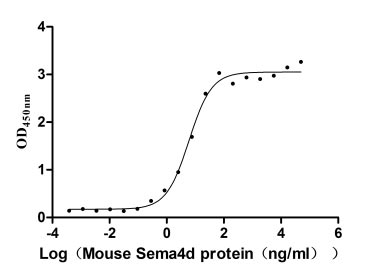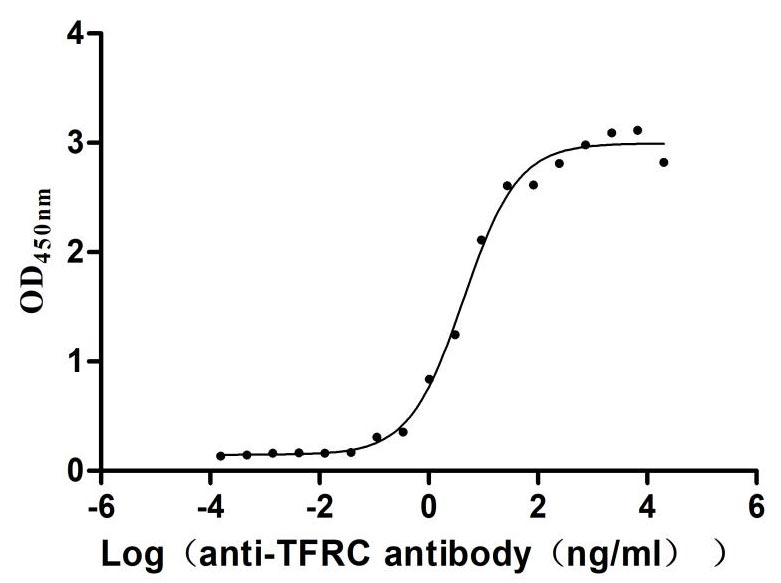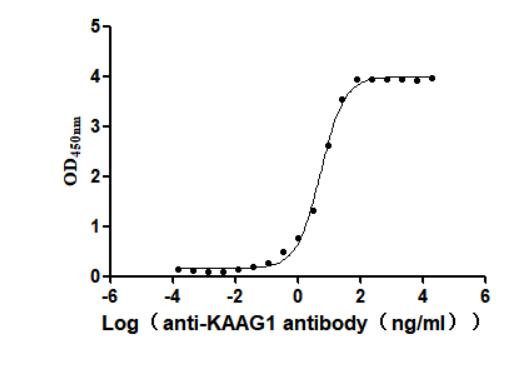Recombinant Mouse G-protein coupled receptor 55 (Gpr55), partial
-
货号:CSB-YP661042MO1
-
规格:
-
来源:Yeast
-
其他:
-
货号:CSB-EP661042MO1
-
规格:
-
来源:E.coli
-
其他:
-
货号:CSB-EP661042MO1-B
-
规格:
-
来源:E.coli
-
共轭:Avi-tag Biotinylated
E. coli biotin ligase (BirA) is highly specific in covalently attaching biotin to the 15 amino acid AviTag peptide. This recombinant protein was biotinylated in vivo by AviTag-BirA technology, which method is BriA catalyzes amide linkage between the biotin and the specific lysine of the AviTag.
-
其他:
-
货号:CSB-BP661042MO1
-
规格:
-
来源:Baculovirus
-
其他:
-
货号:CSB-MP661042MO1
-
规格:
-
来源:Mammalian cell
-
其他:
产品详情
-
纯度:>85% (SDS-PAGE)
-
基因名:
-
Uniprot No.:
-
别名:Gpr55; Gm218; G-protein coupled receptor 55
-
种属:Mus musculus (Mouse)
-
蛋白长度:Partial
-
蛋白标签:Tag type will be determined during the manufacturing process.
The tag type will be determined during production process. If you have specified tag type, please tell us and we will develop the specified tag preferentially. -
产品提供形式:Lyophilized powder
Note: We will preferentially ship the format that we have in stock, however, if you have any special requirement for the format, please remark your requirement when placing the order, we will prepare according to your demand. -
复溶:We recommend that this vial be briefly centrifuged prior to opening to bring the contents to the bottom. Please reconstitute protein in deionized sterile water to a concentration of 0.1-1.0 mg/mL.We recommend to add 5-50% of glycerol (final concentration) and aliquot for long-term storage at -20℃/-80℃. Our default final concentration of glycerol is 50%. Customers could use it as reference.
-
储存条件:Store at -20°C/-80°C upon receipt, aliquoting is necessary for mutiple use. Avoid repeated freeze-thaw cycles.
-
保质期:The shelf life is related to many factors, storage state, buffer ingredients, storage temperature and the stability of the protein itself.
Generally, the shelf life of liquid form is 6 months at -20°C/-80°C. The shelf life of lyophilized form is 12 months at -20°C/-80°C. -
货期:Delivery time may differ from different purchasing way or location, please kindly consult your local distributors for specific delivery time.Note: All of our proteins are default shipped with normal blue ice packs, if you request to ship with dry ice, please communicate with us in advance and extra fees will be charged.
-
注意事项:Repeated freezing and thawing is not recommended. Store working aliquots at 4°C for up to one week.
-
Datasheet :Please contact us to get it.
相关产品
靶点详情
-
功能:Receptor for L-alpha-lysophosphatidylinositol (LPI). LPI induces Ca(2+) release from intracellular stores via the heterotrimeric G protein GNA13 and RHOA. Putative cannabinoid receptor. May play a role in bone physiology by regulating osteoclast number and function. May be involved in hyperalgesia associated with inflammatory and neuropathic pain.
-
基因功能参考文献:
- Genetic deletion of GPR55 did not alter the development of pathological pain in adult mice in any chronic pain model evaluated. PMID: 28428628
- GPR55 plays an important role in anxiety. PMID: 28800762
- This study demonstrated that the GPR55 modulates hippocampal synaptic plasticity. PMID: 28653801
- our data suggest that GPR55 and CB1 play differential roles in colon carcinogenesis where the former seems to act as oncogene and the latter as tumor suppressor. PMID: 28875496
- GPR55 was highly expressed by beta-cells of both humans and mice. It was also present in a small proportion of mouse islet alpha-cells and in the majority of human islet alpha-cells, but it was absent or at very low levels in delta-cells of both species. GPR55 was preferentially expressed in the endocrine pancreas, with only faint immunoreactivity in the exocrine pancreas in mice and humans. PMID: 27561953
- GPR55 agonist lysophosphatidylinositol and lysophosphatidylcholine inhibit endothelial cell hyperpolarization via GPR-independent suppression of Na(+)-Ca(2+) exchanger and endoplasmic reticulum Ca(2+) refilling. PMID: 28064014
- Gpr55 deficiency is associated with subtle effects on energy expenditure and motor activity behaviours but does not appear per se critically required for overall metabolism or behaviours PMID: 27941994
- GPR55 has an important role in energy homeostasis. GPR55 ablation increases adiposity and insulin resistance by selectively decreasing physical activity, but not by altering feeding behavior as CB1. PMID: 26447738
- Results indicate that GPR55 modulates the growth rate and the targets innervation of retinal projections and highlight, for the first time, an important role of GPR55 in axon refinement during development PMID: 26730399
- expression of CB1 and GPR55 in proximal tubules is altered in response to elevated levels of glucose and albumin PMID: 25545857
- Data show evidence of GPR55 involvement in central pain processing and unravel a novel Ca2+-mediated mechanism by which periaqueductal gray neurons are activated downstream of GPR55. PMID: 25972448
- Mice deficient in GPR55 exhibit maladaptive adrenergic signalling, as evidenced by the reduced contractile reserve. PMID: 25275556
- GPR55 is distributed in pancreatic beta cells and is a strong activator of insulin secretion, with glucose-lowering effects in vivo. Development of agents agonizing the GPR55 receptor may have therapeutic potential in the treatment of type 2 diabetes. PMID: 23992544
- Data (including data from knockout mice) suggest that GPR55 is strongly expressed on myenteric neurons of the colon and that GPR55 is selectively involved in the regulation of colonic motility. PMID: 23603203
- GPR55 plays a role in motor coordination, but does not strongly regulate CNS development, gross motor movement or several types of learned behavior. PMID: 23565223
- GPR55 drives mouse skin tumor development. PMID: 22751111
- Cannabinoid- and lysophosphatidylinositol-sensitive receptor GPR55 boosts neurotransmitter release at central synapses. PMID: 23472002
- Data show that G protein-coupled receptor 55 exists throughout the intestines of rats, and that O-1602 or CBD selectively normalized motility disturbances due to inflammation. PMID: 21726355
- Data show that activation of GPR55 in pancreatic islets with the agonist O-1602 increased glucose-stimulated insulin secretion (GSIS), but this effect was blunted in islets from Gpr55 KO mice. PMID: 21885477
- Use fluorescent ligand binding to examine GPR55 distribution in arteries. PMID: 20136833
- In a model of neuropathic hypersensitivity, there is no mechanical hyperalgesia present in male or female GPR55-deficient mice at any time point up to 28 days post-ligation. PMID: 18502582
- GPR55 might be involved in neuroinflammation and its expression is controlled by the state of microglial activation. PMID: 19464294
- Data reveal a role of GPR55 in bone physiology by regulating osteoclast number and function. PMID: 19805329
显示更多
收起更多
-
亚细胞定位:Cell membrane; Multi-pass membrane protein.
-
蛋白家族:G-protein coupled receptor 1 family
-
数据库链接:
KEGG: mmu:227326
STRING: 10090.ENSMUSP00000084196
UniGene: Mm.244158
Most popular with customers
-
Recombinant Mouse Semaphorin-4D (Sema4d), partial (Active)
Express system: Mammalian cell
Species: Mus musculus (Mouse)
-
Recombinant Human Tyrosine-protein kinase Mer (MERTK), partial (Active)
Express system: Mammalian cell
Species: Homo sapiens (Human)
-
Recombinant Rat Intestinal-type alkaline phosphatase 1 (Alpi) (Active)
Express system: Mammalian cell
Species: Rattus norvegicus (Rat)
-
Recombinant Human Transferrin receptor protein 1 (TFRC), partial (Active)
Express system: Mammalian cell
Species: Homo sapiens (Human)
-
Recombinant Human Cytotoxic and regulatory T-cell molecule (CRTAM), partial (Active)
Express system: Mammalian cell
Species: Homo sapiens (Human)
-
Recombinant Human Carcinoembryonic antigen-related cell adhesion molecule 8(CEACAM8) (Active)
Express system: Mammalian cell
Species: Homo sapiens (Human)
-
Recombinant Human Kidney-associated antigen 1(KAAG1) (Active)
Express system: Baculovirus
Species: Homo sapiens (Human)
-
Recombinant Human Interleukin-12 receptor subunit beta-1(IL12RB1),partial (Active)
Express system: Mammalian cell
Species: Homo sapiens (Human)




















